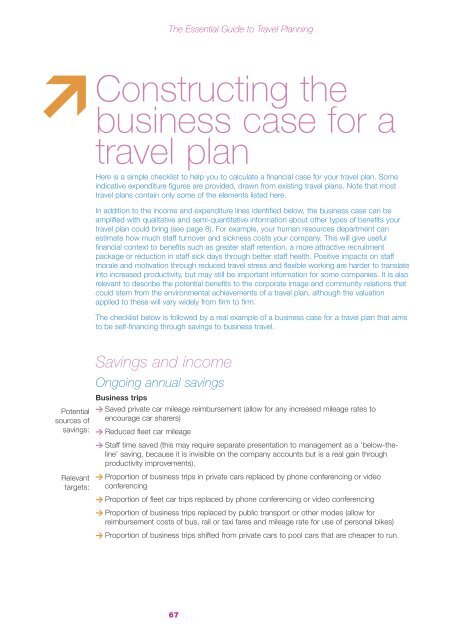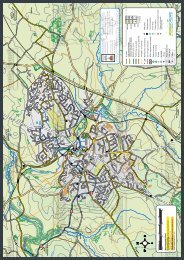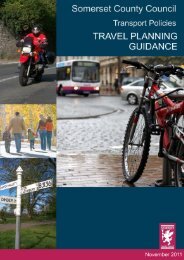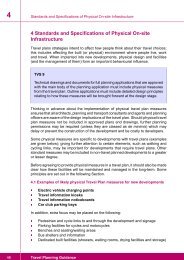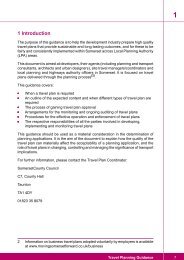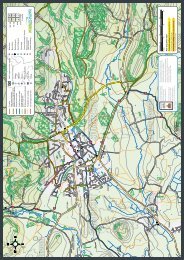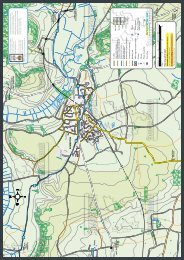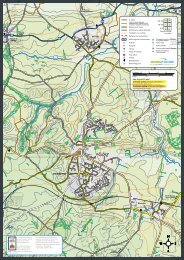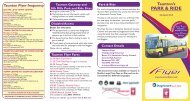Constructing the business case for a travel plan - Moving Somerset ...
Constructing the business case for a travel plan - Moving Somerset ...
Constructing the business case for a travel plan - Moving Somerset ...
Create successful ePaper yourself
Turn your PDF publications into a flip-book with our unique Google optimized e-Paper software.
The Essential Guide to Travel Planning<br />
<<br />
<strong>Constructing</strong> <strong>the</strong><br />
<strong>business</strong> <strong>case</strong> <strong>for</strong> a<br />
<strong>travel</strong> <strong>plan</strong><br />
Here is a simple checklist to help you to calculate a financial <strong>case</strong> <strong>for</strong> your <strong>travel</strong> <strong>plan</strong>. Some<br />
indicative expenditure figures are provided, drawn from existing <strong>travel</strong> <strong>plan</strong>s. Note that most<br />
<strong>travel</strong> <strong>plan</strong>s contain only some of <strong>the</strong> elements listed here.<br />
In addition to <strong>the</strong> income and expenditure lines identified below, <strong>the</strong> <strong>business</strong> <strong>case</strong> can be<br />
amplified with qualitative and semi-quantitative in<strong>for</strong>mation about o<strong>the</strong>r types of benefits your<br />
<strong>travel</strong> <strong>plan</strong> could bring (see page 8). For example, your human resources department can<br />
estimate how much staff turnover and sickness costs your company. This will give useful<br />
financial context to benefits such as greater staff retention, a more attractive recruitment<br />
package or reduction in staff sick days through better staff health. Positive impacts on staff<br />
morale and motivation through reduced <strong>travel</strong> stress and flexible working are harder to translate<br />
into increased productivity, but may still be important in<strong>for</strong>mation <strong>for</strong> some companies. It is also<br />
relevant to describe <strong>the</strong> potential benefits to <strong>the</strong> corporate image and community relations that<br />
could stem from <strong>the</strong> environmental achievements of a <strong>travel</strong> <strong>plan</strong>, although <strong>the</strong> valuation<br />
applied to <strong>the</strong>se will vary widely from firm to firm.<br />
The checklist below is followed by a real example of a <strong>business</strong> <strong>case</strong> <strong>for</strong> a <strong>travel</strong> <strong>plan</strong> that aims<br />
to be self-financing through savings to <strong>business</strong> <strong>travel</strong>.<br />
Potential<br />
sources of<br />
savings:<br />
Relevant<br />
targets:<br />
Savings and income<br />
Ongoing annual savings<br />
Business trips<br />
> Saved private car mileage reimbursement (allow <strong>for</strong> any increased mileage rates to<br />
encourage car sharers)<br />
> Reduced fleet car mileage<br />
> Staff time saved (this may require separate presentation to management as a ‘below-<strong>the</strong>line’<br />
saving, because it is invisible on <strong>the</strong> company accounts but is a real gain through<br />
productivity improvements).<br />
> Proportion of <strong>business</strong> trips in private cars replaced by phone conferencing or video<br />
conferencing<br />
> Proportion of fleet car trips replaced by phone conferencing or video conferencing<br />
> Proportion of <strong>business</strong> trips replaced by public transport or o<strong>the</strong>r modes (allow <strong>for</strong><br />
reimbursement costs of bus, rail or taxi fares and mileage rate <strong>for</strong> use of personal bikes)<br />
> Proportion of <strong>business</strong> trips shifted from private cars to pool cars that are cheaper to run.<br />
67
<strong>Constructing</strong> <strong>the</strong> <strong>business</strong> <strong>case</strong> <strong>for</strong> a <strong>travel</strong> <strong>plan</strong><br />
Potential<br />
sources of<br />
savings:<br />
Car parking<br />
> Reduced car park rental charges<br />
> Reduced car park maintenance<br />
> Provision of car parking spaces costs companies about £400 on average nationwide, £2000<br />
in outer London, rising to £6000 in central London.<br />
> These savings may both have an additional ‘below-<strong>the</strong>-line’ component, which is <strong>the</strong><br />
avoided cost of ongoing rent or maintenance in <strong>case</strong>s where fur<strong>the</strong>r car parking would be<br />
needed without a <strong>travel</strong> <strong>plan</strong>.<br />
Relevant<br />
targets:<br />
> Reduction in car journeys to site, which in turn may reflect sub-targets <strong>for</strong> each <strong>travel</strong> <strong>plan</strong><br />
measure.<br />
Potential<br />
sources of<br />
savings:<br />
Relevant<br />
targets:<br />
Accommodation costs<br />
> Increased utilisation of existing sites and buildings<br />
> Homeworking and satellite office working<br />
> Reduction in car journeys to site (where site utilisation is limited by access and parking<br />
ra<strong>the</strong>r than capacity of <strong>the</strong> buildings).<br />
Potential<br />
sources of<br />
savings:<br />
Relevant<br />
targets:<br />
Perk cars<br />
> Savings from not offering company cars and associated packages (allow <strong>for</strong> cost of<br />
replacement packages and possibility of phasing in change over time with staff turnover).<br />
> Proportion of staff switched from car-based perks packages, which will hold implications <strong>for</strong><br />
establishing o<strong>the</strong>r benefits packages, such as season ticket allowances, and may imply<br />
establishing pool vehicles <strong>for</strong> <strong>business</strong> use.<br />
Unproductive <strong>travel</strong> time<br />
> As well as staff time savings from cutting <strong>business</strong> trips (mentioned above), homeworking or<br />
satellite office working can save substantial amounts of staff time. Clearly, this is harder to<br />
quantify, but companies with strong flexible working cultures claim that <strong>the</strong>y have achieved<br />
better productivity.<br />
Potential<br />
sources of<br />
income:<br />
Ongoing income<br />
Car parking<br />
> Car parking fees (range from 10p/day to 75p/day, taking five current examples)<br />
Bus fares<br />
> Supporting buses will be a net cost <strong>for</strong> your <strong>travel</strong> <strong>plan</strong>, but in constructing your <strong>business</strong><br />
<strong>case</strong> you should remember that many firms recoup a proportion of <strong>the</strong> cost from staff.<br />
68
The Essential Guide to Travel Planning<br />
Potential<br />
sources of<br />
savings:<br />
One-off savings<br />
Car parking<br />
> Avoided land purchase and construction costs of building a new car park (£1000 – £3000<br />
per space construction cost, even <strong>for</strong> surface-level car parks)<br />
> Proceeds from selling off portion of car park or developing it <strong>for</strong> own use or <strong>for</strong> sale.<br />
NB Possible grants are not shown here, but funding may be available <strong>for</strong> some <strong>travel</strong> <strong>plan</strong><br />
facilities, <strong>for</strong> example from local authorities, and may make a significant difference to your<br />
<strong>business</strong> <strong>case</strong>.<br />
Expenditure<br />
Ongoing annual expenditure<br />
Travel <strong>plan</strong> coordinator<br />
Salary plus overheads £40,000<br />
Car share database<br />
Annual software licence £500–1,000<br />
Marketing<br />
Publicity, in<strong>for</strong>mation, promotional events £5,000–20,000<br />
Guaranteed ride home<br />
Emergency taxis <strong>for</strong> staff who car share or use public transport £100–2,000<br />
Shuttle bus service<br />
Funding <strong>for</strong> one shuttle bus route £50,000–100,000<br />
Incentive schemes<br />
£1/day <strong>for</strong> 500 staff who <strong>travel</strong> to work sustainably £130,000<br />
One-off expenditure<br />
Initial survey<br />
Survey and analysis, if not done in-house £10,000<br />
Car share database<br />
Set up £500–3,000<br />
Cycling facilities<br />
10 lockers £500–1,000<br />
Shower and changing facilities £5,000–10,000<br />
Secure cycle parking area £5,000<br />
1 kilometre of new tarmac topped cycle route £70,000<br />
Walking facilities<br />
Significant infrastructure (e.g. new crossings, traffic calming) £30,000–100,000<br />
69
<strong>Constructing</strong> <strong>the</strong> <strong>business</strong> <strong>case</strong> <strong>for</strong> a <strong>travel</strong> <strong>plan</strong><br />
Real-life <strong>business</strong> <strong>case</strong><br />
The following <strong>business</strong> <strong>case</strong> is <strong>for</strong> a <strong>travel</strong> <strong>plan</strong> funded through savings in <strong>business</strong> <strong>travel</strong>.<br />
Background<br />
1000 staff spread across four offices in a rural region with limited public transport.<br />
Data from staff survey<br />
85% of <strong>business</strong> trips are staff driving <strong>the</strong>ir own cars, <strong>for</strong> which <strong>the</strong>y receive 42p/mile.<br />
Presently very few <strong>business</strong> trips are car shared. However, <strong>the</strong> survey revealed that up to a<br />
quarter of <strong>the</strong> <strong>business</strong> journeys could have been made by car sharing or public transport – by<br />
employees’ own assessment. There is presently little or no telephone conferencing or video<br />
conferencing even though a significant proportion of journeys are between offices.<br />
Targets set<br />
Senior managers decided to set a target <strong>for</strong> 10% reduction in <strong>business</strong> mileage over three<br />
years. To achieve this, 8% of <strong>business</strong> trips need to be car shared and 33% of <strong>the</strong> inter-office<br />
trips need to be replaced by telephone conference. The car share target was set at <strong>the</strong><br />
proportion of <strong>business</strong> journeys that <strong>the</strong> survey respondents said <strong>the</strong>y could share. The interoffice<br />
trip target drew on reductions achieved through telephone conferencing by organisations<br />
that had started from broadly similar circumstances. Although <strong>the</strong> adopted <strong>travel</strong> <strong>plan</strong> included<br />
measures to promote all sustainable modes, including public transport, managers decided not<br />
to include potential savings from <strong>the</strong>se o<strong>the</strong>r measures in <strong>the</strong> core <strong>business</strong> <strong>case</strong>.<br />
Projected savings<br />
> £106,000 per year (during year 4) from saved mileage claims (270,000 miles per year).<br />
See first table below.<br />
> An additional £54,000 per year (at year 4) if staff time saved by teleconferencing instead of<br />
<strong>travel</strong>ling between offices is factored in. See second table below.<br />
> An additional £100,000 per year (by year 6) if a pool car scheme is implemented to begin to<br />
replace use of personal cars. This saving would be additional to <strong>the</strong> tables below.<br />
6-year projections<br />
Costs and benefits not taking account of savings in staff <strong>travel</strong> time<br />
Salary Capital Revenue Forecast Annual net Cumulative<br />
costs budget budget gross savings savings<br />
savings<br />
Year 1 £30,533 £9,000 £26,000 £19,957 -£45,576 -£45,576<br />
Year 2 £31,449 £36,050 £57,768 -£9,731 -£55,307<br />
Year 3 £32,393 £37,132 £97,127 £27,602 -£27,705<br />
Year 4 £33,365 £38,245 £106,458 £34,848 £7,143<br />
Year 5 £34,366 £39,393 £115,878 £42,120 £49,263<br />
Year 6 £35,396 £40,575 £125,349 £49,378 £98,640<br />
70
The Essential Guide to Travel Planning<br />
Costs and benefits with account taken of savings in staff <strong>travel</strong> time<br />
Salary Capital Revenue Forecast Annual net Cumulative<br />
costs budget budget gross savings savings<br />
savings<br />
Year 1 £30,533 £9,000 £26,000 £30,352 -£35,181 -£35,181<br />
Year 2 £31,449 £36,050 £88,368 £20,869 -£14,312<br />
Year 3 £32,393 £37,132 £149,627 £80,102 £65,790<br />
Year 4 £33,365 £38,245 £160,533 £88,923 £154,713<br />
Year 5 £34,366 £39,393 £171,576 £97,817 £252,530<br />
Year 6 £35,396 £40,575 £182,717 £106,746 £359,276<br />
The capital budget allocation is mainly <strong>for</strong> telephone conferencing facilities and set-up of a car<br />
sharing database. The revenue budget is <strong>for</strong> promotional activities, in<strong>for</strong>mation and incentives<br />
<strong>for</strong> sustainable <strong>travel</strong>. A small grant <strong>for</strong> on-site cycling facilities is not included. The <strong>travel</strong> <strong>plan</strong><br />
does not anticipate any civil engineering infrastructural work or funding of dedicated bus<br />
services. First year figures make allowance <strong>for</strong> a period to get <strong>the</strong> <strong>travel</strong> <strong>plan</strong> coordinator post<br />
up and running.<br />
Basis <strong>for</strong> projections<br />
> Telephone conferencing will cut car mileage between offices by 9% after one year; 20% after<br />
two years; and 33% after three years. Fur<strong>the</strong>r small increases in telephone conferencing will<br />
be achieved in years 4–6, replacing an additional 1% of ‘between-office’ mileage per year.<br />
> Car sharing will cut <strong>business</strong> car mileage by 1.6% after one year; 4.8% after two years; and<br />
8% after three years. This is based on employees’ own assessment that 8% of <strong>the</strong>ir current<br />
car trips could potentially be made as a car share. Fur<strong>the</strong>r cuts of 1% of <strong>business</strong> mileage<br />
are achieved in subsequent years.<br />
> A car sharing allowance of 5p per mile, payable to drivers, is introduced.<br />
> In <strong>the</strong> first year, passengers are also paid 5p per mile to car share.<br />
> The mileage rate at which savings are calculated will be 42p per mile in year 1 and rise by<br />
1p in each subsequent year.<br />
> All costs are inflated by 3% per annum.<br />
71


